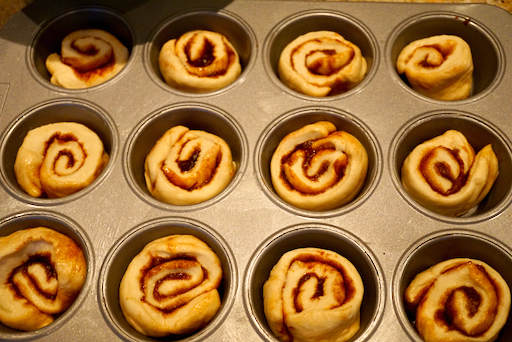This is one of my wife's baking projects. Since we really liked our old friend the “tried-and-true buttermilk biscuit she used to make many years ago and reintroduced to our diet recently, when she found a recipe labeled “better” buttermilk biscuits, she had to try it. This is basically a "redux" of the previous recipe with some improvements. The major difference is that it includes an egg. It also has a slightly different way of doing the envelop folds that cause the flakey layers such as those shown in the picture below. The end product is very flakey but a bit more moist which makes it a bit better than the previous recipe. As usual I will ask my wife to with "how-to"es.
Ingredients:
3 cups (360 gr.) flour (or 2 cups AP flour and 1 cup plus 2 Tbs. Cake flour)
3 Tbs. Sugar
2 1/2 tsp baking powder
3/4 tsp. Salt
1/2 tsp. Baking soda
1 1/2 stick (170 gr.) cold butter cut into small cubes (I froze the butter cubes)
1 large egg
3/4 cup (180 Milliliters) cold buttermilk
Directions:
Mix the dry ingredients (flour through soda) in a bowl. Using your hands quickly work the butter into the dry ingredients until the pieces of butter are the size of small beans. (It’s ok to have the butter in visible chunks because that is what contributes to the flakiness). In another bowl combine the egg and the buttermilk. Whisk with a fork to combine. Add the wet ingredients to the dry ingredients. Lightly mix until a crumbly dough forms. Turn out onto a floured surface and using a rolling pin roll the dough into a 1 inch thick 2 1/2 inch wide strip with the narrow end facing you. Fold the dough into thirds as you would a letter. (This creates a thin but long strip of dough which is a slightly different from the usual configuration of a square which is then folded). Turn the dough one quarter turn, roll out into 1 inch thick 2 1/2 inch wide and fold again. Turn, roll it out and fold again. Roll it out one final time and cut into 12 pieces. Put on a cookie sheet covered in parchment paper. Cook in a 400 degree oven for 18 to 20 minutes until the biscuits are golden brown. (If you used frozen butter you may cook a little longer to make sure the centers are cooked.) Cool on a rack.
These biscuits were excellent. They were flakey, had a slight sweetness, the tang of the butter milk and and taste of butter. While they were nicely flakey they were also very moist on the inside. (The biscuits made with the previous recipe while still very good were a bit drier.) This will probably be the buttermilk biscuit recipe we will use in the future.


















